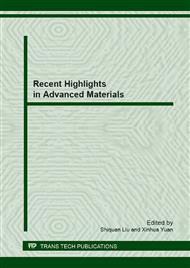[1]
M. Hossain, G. Possart, P. Steinmann, A small-strain model to simulate the curing of thermosets, Comput. Mech. 43 (2009) 769-779.
DOI: 10.1007/s00466-008-0344-5
Google Scholar
[2]
V. Mucci, G. Arenas, R. Duchowicz, W.D. Cook, C. Vallo, Influence of thermal expansion on shrinkage during photopolymerization of dental resins based on bis-GMA/TEGDMA, Dent. Mater. 25 (2009) 103-114.
DOI: 10.1016/j.dental.2008.04.014
Google Scholar
[3]
X. Zeng, J. Raghavan, Role of tool-part interaction in process-induced warpage of autoclave-manufactured composite structures, Composites Part A. 41 (2010) 1174-1183.
DOI: 10.1016/j.compositesa.2010.04.017
Google Scholar
[4]
P.P. Parlevliet, H.E.N. Bersee, A. Beukers, Residual stresses in thermoplastic composites-a study of the literature. Part III: Effects of thermal residual stresses, Composites Part A. 38 (2007) 1581-1596.
DOI: 10.1016/j.compositesa.2006.12.005
Google Scholar
[5]
S. Tseng, T.A. Osswald, Prediction of shrinkage and warpage of fiber reinforced thermoset composite parts, J. Reinf. Plast. Compos. 13 (1994) 698-721.
DOI: 10.1177/073168449401300803
Google Scholar
[6]
Y.K. Kim, S.R. White, Process-induced stress relaxation analysis of AS4/3501-6 laminate, J. Reinf. Plast. Compos. 16 (1997) 2-16.
DOI: 10.1177/073168449701600102
Google Scholar
[7]
A. Johnston, R. Vaziri, A. Poursartip, A plane strain model for process-induced deformation of laminated composite structures, J. Compos. Mater. 35 (2001) 1435-1469.
DOI: 10.1177/002199801772662514
Google Scholar
[8]
H.Y. Hwang, Y.K. Kim, C. Rim, Y.D. Kwon, W. Choi, Thermo-viscoelastic residual stress analysis of metal liner-inserted composite cylinders, KSME Int J. 17 (2003) 171-180.
DOI: 10.1007/bf02984387
Google Scholar
[9]
X.X. Wang, C.G. Wang, Y.X. Jia, L. Luo, P. Li, Cure-volume-temperature relationships of epoxy resin and graphite/epoxy composites, Polymer. 53 (2012) 4152-4156.
DOI: 10.1016/j.polymer.2012.07.039
Google Scholar
[10]
A. Cheung, Y. Yu, K. Pochiraju, Three-dimensional finite element simulation of curing of polymer composites, Fin. Elem. Anal. Des. 40 (2004) 895-912.
DOI: 10.1016/s0168-874x(03)00119-7
Google Scholar
[11]
A.C. Loos, G.S. Springer, Curing of epoxy matrix composites, J. Compos. Mater. 17 (1983) 135-169.
Google Scholar
[12]
C.H. Li, S.J. Hwang, Study of warpage due to P-V-T-C relation of EMC in IC packaging, IEEE T Compon Pack T. 27 (2004) 291-295.
DOI: 10.1109/tcapt.2004.828579
Google Scholar
[13]
T.A. Bogetti, J.W. Gillespie, Process-induced stress and deformation in thick-section thermoset composite laminates, J. Compos. Mater. 26 (1992) 626-660.
DOI: 10.1177/002199839202600502
Google Scholar
[14]
N. Zobeiry, R. Vaziri, A. Poursartip, Computationally efficient pseudo-viscoelastic models for evaluation of residual stresses in thermoset polymer composites during cure, Composites Part A. 41 (2010) 247-256.
DOI: 10.1016/j.compositesa.2009.10.009
Google Scholar
[15]
Y.K. Kim, S.R. White, Viscoelastic analysis of processing-induced residual stresses in thick composite laminates, Mech. Adv. Mater. Struct. 4 (1997) 361-387.
DOI: 10.1080/10759419708945889
Google Scholar


